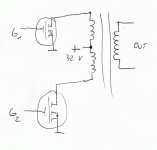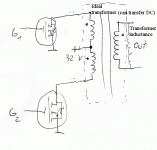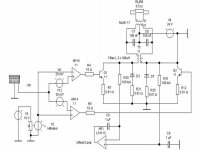Well, if it is forbidden to talk about amps powered straight from mains, then it can be powered from anything else, like a batteries or something.
Is it possible a circuit derived from this could work?
If someone made it before me, please tell me where could i find it or post a schematic. Thanks
Is it possible a circuit derived from this could work?
If someone made it before me, please tell me where could i find it or post a schematic. Thanks
Attachments
Amplifier
Hi There and Happy Christmas.
The circuit you have shown is for a Push-Pull configuration which i suitable for a single supply rail. The circuit is almost the same as a triode output valve amplifier. I have built many amplifiers with this type of output stage, including RF amplifiers. The simplest way of making the circuit work is to drive the two gates with another small centre tapped driver transformer. The centre tap is on the secondary side. The centre tap should be connected to a suitable bias supply which sets the class of operation you wish to use. Personally I have always used a class AB or B set-up as this offers quite low distortion levels. Either side of the driver transformer is connected directly to the gates. The primry can be driven off a single ended design, even a single transistor will work as no drive power is required in class AB.
The one thing you must do is use FETs which are designed for audio use, as these will give a good linear transfer characteristic. BUZ900s are excellent. At present I do not have a drawing package available so cannot provide a circuit diagram. I hope the comments I have made are at least useful.
regards,
Steve Hawkins
Hi There and Happy Christmas.
The circuit you have shown is for a Push-Pull configuration which i suitable for a single supply rail. The circuit is almost the same as a triode output valve amplifier. I have built many amplifiers with this type of output stage, including RF amplifiers. The simplest way of making the circuit work is to drive the two gates with another small centre tapped driver transformer. The centre tap is on the secondary side. The centre tap should be connected to a suitable bias supply which sets the class of operation you wish to use. Personally I have always used a class AB or B set-up as this offers quite low distortion levels. Either side of the driver transformer is connected directly to the gates. The primry can be driven off a single ended design, even a single transistor will work as no drive power is required in class AB.
The one thing you must do is use FETs which are designed for audio use, as these will give a good linear transfer characteristic. BUZ900s are excellent. At present I do not have a drawing package available so cannot provide a circuit diagram. I hope the comments I have made are at least useful.
regards,
Steve Hawkins
I think so. The inductance of the transformer has to be so large, that high currents dosn't build up inside it. You'll also have to figure out a way, to avoid that no DC levels are beeing transfered, since that current of the transformer inductance will only be limited by the winding resistance then.
If you want to use a small high frequency transformer, then you probably have to figure out another topology.
I've attached an equivalent circuit of you're schematic.
You have to be aware of the mosfet diodes, so I've added them too.
If you want to use a small high frequency transformer, then you probably have to figure out another topology.
I've attached an equivalent circuit of you're schematic.
You have to be aware of the mosfet diodes, so I've added them too.
Attachments
Does it need a transformer that could handle frequencies from 20Hz to 300KHz?
No it needs a transformer that goes from 20 Hz to >300 kHz unfortunately !

The ampliverter that was already mentioned would indeed be better in this respect since it is basically consisting of a DC/DC converter with synchronous rectification (having selectable polarity) where output amplitude and polarity is controlled by the input signal. It would only need a small transformer as any other SMPS.
Regards
Charles
snip kubeek
"If someone made it before me, please tell me where could i find it or post a schematic."
Hello kubeek,
long time ago I tried some simulations with this kind of switching
converter You see in the attachment.
The transfomer gets no HF, because the circuit need a filter,
here with a 1:1 transforming choke with good coupling.
(bifilar-windings!).
You need also a difference-integrator to get the primary-offset.
Because this offset has to be near zero You need a additional regulator for this!
Simulations worked fine but I don´t go further because I don´t like the big transformer!
My advice:
Try it only if You have a lot of experience!
Even a simulation can offer You some (convergence) problems!
Regards
Heinz!
"If someone made it before me, please tell me where could i find it or post a schematic."
Hello kubeek,
long time ago I tried some simulations with this kind of switching
converter You see in the attachment.
The transfomer gets no HF, because the circuit need a filter,
here with a 1:1 transforming choke with good coupling.
(bifilar-windings!).
You need also a difference-integrator to get the primary-offset.
Because this offset has to be near zero You need a additional regulator for this!
Simulations worked fine but I don´t go further because I don´t like the big transformer!

My advice:
Try it only if You have a lot of experience!
Even a simulation can offer You some (convergence) problems!
Regards
Heinz!
Attachments
Yes, in my thoughts I got to something similar (little bit simpler), but I realized that there is no advantage in this kind of circuit, because i will always need an usual transformer for audio band rated for the output power. And such would be pretty big and heavy, so i can go back to usual amp and get a good power supply.
Kenshin said:There was once a circuit of this kind , published on a Chinese magazine, which actually used a small high frequency toroid.
Would you be please so kind and find it? Thanks
- Status
- This old topic is closed. If you want to reopen this topic, contact a moderator using the "Report Post" button.
- Home
- Amplifiers
- Class D
- D-class amp NOT powered straight from mains


